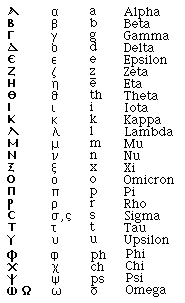Greek
Greek Alphabet
 Our first evidence for the Greek language comes from Linear B tablets which date to the later Bronze Age (c. 1200 B.C. – on the mainland) and were written in a syllabary. Some time in the 10th century (perhaps?) the Greeks adopted the Phoenician alphabet, with modifications, and our earliest writing with the Greek alphabet comes from the last half of the 8th century. The Greek of Homer’s Iliad and Odyssey (and other early works) has certain features that disappear in later Greek – for instance the “w” sound (the letter was called a digamma), the tolerance for “open” vowels (two vowels next to each other that don’t contract), and a long alpha (a) in many forms.
Our first evidence for the Greek language comes from Linear B tablets which date to the later Bronze Age (c. 1200 B.C. – on the mainland) and were written in a syllabary. Some time in the 10th century (perhaps?) the Greeks adopted the Phoenician alphabet, with modifications, and our earliest writing with the Greek alphabet comes from the last half of the 8th century. The Greek of Homer’s Iliad and Odyssey (and other early works) has certain features that disappear in later Greek – for instance the “w” sound (the letter was called a digamma), the tolerance for “open” vowels (two vowels next to each other that don’t contract), and a long alpha (a) in many forms.
The classical period for Greek stretches from about 750 B.C. to 350/330 B.C. and during this time different dialects developed in different areas. The Attic dialect was spoken around Athens and much of the great literature was therefore written in this dialect (Aeschylus, Sophocles, Euripides, Thucydides, Plato, etc.). You will learn Attic (or Attic-Ionic) in the first year class. In Attic Greek the long alpha of the early period has turned into a long eta (e) except after a short e (epsilon), iota (i), or rho (r), and in Ionic the eta has replaced the alpha altogether.
Koine is “common” Greek – the language spoken by regular people from c. 330 B.C. – 330 A.D. Scholars used to think it was a “debased” form of Greek used especially by the Hebrews and confined more or less to translations of the Old Testament and to the New Testament. The discovery of papyri and inscriptions during this past century, however, has shown that this “Biblical Greek” was, in fact, used commonly. Koine differs from the more literary Attic/Ionic dialects mostly by being simpler. It uses fewer subordinate constructions, prefers direct speech to indirect speech, makes much less use of the optative mood, and simplifies certain forms.





